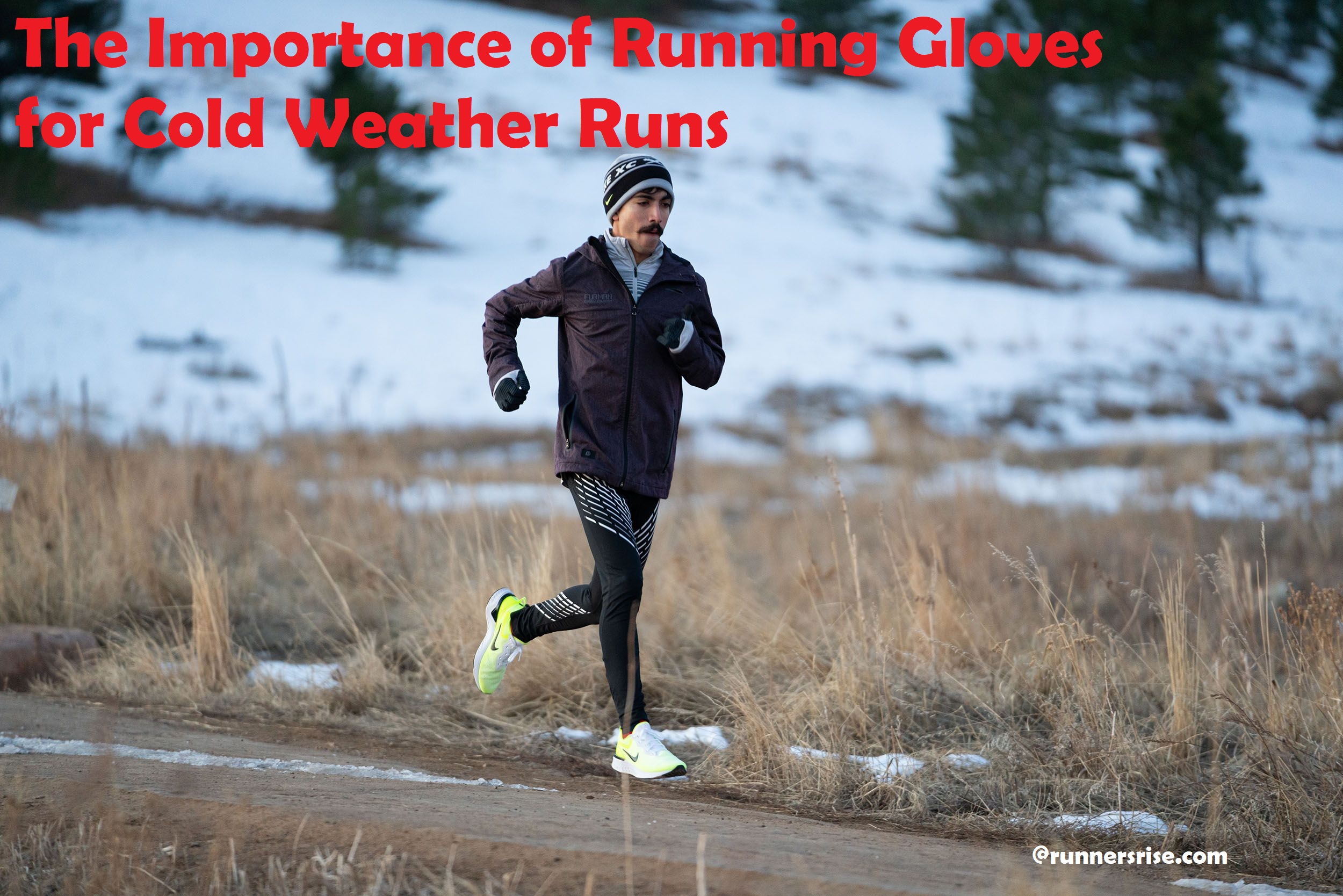Are you a runner who needs to brave the cold weather? If so, running gloves are a must-have for your winter wardrobe. You don’t want cold hands to stop your strides!
This comprehensive guide explains why running gloves are important and the many features they offer. Be prepared for the chill and let’s get started!
Running in cold weather can be hard on your body and hands. No matter how well you dress for the conditions, your fingers tend to be highly susceptible to the chill — even when wearing gloves or mittens. This is why dedicated running gloves are a great choice when it comes to cold-weather workouts. While regular gloves can provide some warmth (and are great for other activities like snow-blowing, shoveling snow, and building a snowman!), they’re not designed with running in mind — more specifically, keeping your hands warm while maintaining mobility of your fingers so you can use them as usual.
Running gloves usually have padded grips on the palms that allow you to hold onto essential items like water bottles and energy gels. And since they’re thin and lightweight, they won’t add much bulk or weight so you don’t feel like your gripping too much while running. Dedicated running gloves are designed specifically to keep your hands warm while providing enough dexterity for fiddling with small items such as phones, energy bars, and GPS watches — all without sacrificing comfort or performance.
Benefits of Running Gloves in Cold Weather
Running gloves in cold weather provide a number of benefits to the runner. Wearing gloves can help protect your hands from frostbite and other cold-weather related injuries. In addition, they can keep your hands warm while avoiding overheating and sweating, which reduces the risk of developing blisters or chafing on your palms.
Additionally, they can make it easier to grip running accessories such as keys, hydration packs, and any other items you might be carrying while running. By wearing gloves in cold weather, you may also reduce the amount of time needed for warming up your hands completely before starting a run or exercise session.
Protection from the cold
Cold weather is not just inconvenient—it can also be downright dangerous. Before heading out into temperatures below freezing, it’s important to understand the potential risks and be prepared with the right protective gear, including running gloves.
Running gloves provide insulation to keep hands warm in cold weather by trapping heat. The fabric of most winter running gloves is designed to wick away moisture, allowing you to stay dry without adding extra bulk or weight. This layer of protection also helps block out wind chill which can cause skin temperatures to drop rapidly. In addition, some running gloves have anti-slip features for improved grip on slippery surfaces like icy roads or trails.
The type of glove you need depends on the temperature outside and your own personal comfort level from outdoors activities in extreme cold weather; light insulation may be enough when conditions are mild while heavier gloves may be necessary if you’re braving colder temperatures. Many runners opt for mittens as they tend to retain more warmth than traditional fingered designs, especially if your fingers get cold easily. For added comfort and protection in winter environments, make sure choose a pair of running gloves with ergonomic shaping and adjustable cuffs with elastic or velcro closures that fit snugly around wrists.
Improved grip and dexterity
Cold weather running is a great way to enjoy winter and stay healthy and active. One crucial piece of gear that every winter runner should have in their arsenal is a set of running gloves or mittens. Gloves can provide a number of important benefits to help keep your hands comfortable and prepared for any type of winter activity including running.
One of the primary benefits of wearing running gloves is improved grip and dexterity. When you wear running shoes, you typically need to constantly adjust the laces, which can be difficult if your hands are cold or wet. Running gloves are designed with a grip material on the palms that allows for better grip on lace-up shoes, as well as any other pieces of equipment – such as ski poles – you might be using. Gloves provide extra insulation for your fingers so that they don’t get stiff from being exposed to subzero temperatures too long, allowing you to make those adjustments with ease.
Another benefit of winter gloves is keeping your hand’s warm while outdoors or exercising in extreme weather. Your hands are one area on your body that loses heat quickly due to their low surface area-to-volume ratio; wearing an insulated pair of gloves ensures that these exposed extremities stay warm even during lengthy outdoor activities in frigid temperatures. Most running gloves also feature windproof linings to protect against scouring winds while exercising and reflective stripes or accents which offer high visibility while out on trails and roads at night carrying essential headlights and electronics like phones as needed when traveling alone in icy conditions.
Reduced risk of injury
When running in cold environments, wearing running gloves can reduce the risk of injury, as well as providing additional comfort. Cold temperatures are more likely to cause stiffness and numbness, which can lead to physical discomfort and difficulty managing one’s form while running. This is particularly important when running long distances in colder climates. Wearing gloves ensures that you maintain an appropriate level of warmth and protection against chafing or skin irritation, reducing the risk of sprains, strains or any other muscle or joint issues.
In cold conditions, the obvious benefit of wearing gloves is that they keep your hands warm. This increases circulation and muscular blood flow which in turn helps with hand dexterity, muscle coordination and balance during the run. Additionally, it’s worth noting that if your hands are too warm then sweat will accumulate on them leading to an increase risk for slipping on icy surfaces or wet terrain.
Gloves can also play a vital role in preventing injuries such as blisters – especially when hands are exposed to constant wind-chill throughout a long-distance run; good quality gloves provide a breathable layer between your skin and the elements allowing you to stay dry while maintaining hand dexterity throughout the workout session.
Enhanced comfort and performance
When running in cold weather, a high-quality pair of running gloves can be a great way to boost comfort and performance. These specialized gloves are designed to be warm, breathable and wick moisture away from the skin while remaining lightweight and flexible.
Besides keeping the hands warm, wearing running gloves during cold weather runs can provide additional benefits. These include helping to preserve energy, preventing blisters and abrasions on the hands, as well as reducing inflammation in many parts of the body caused by cold air — such as around the eyes. Wearing gloves with ergonomic designs also help keep your hands comfortable while allowing for better grip control when using poles or other devices.
Performance-wise, running gloves can help prevent distractions that have an impact on accuracy and speed. Poorly designed or too-warm gloves may cause excess sweat buildup within them — leading to a loss of accuracy — or cause your fingers to become too numb to carry out their activities properly. The right pair should fit snugly around your hands but not constrict movement or catch your skin or clothes when you move your arms.
Investing in quality running gloves will ensure you stay comfortable during colder months so you can focus on achieving your goals – whether that’s completing a long distance race or simply taking part in an enjoyable chillier weather run!:max_bytes(150000):strip_icc()/vwt-best-running-gloves-of-2023-tout-25f359012c654ab3ac72d710914be11c.jpg)
Factors to Consider When Choosing Running Gloves
When you are selecting running gloves for cold weather, there are several factors to consider before you make your purchase.
First, look for a glove that fits properly. Too-small running gloves will not keep your hands warm and too big will be uncomfortable and slide off when you are running.
It is also important to look at material composition when picking out gloves. Hot or cold weather conditions can have an effect on the materials available, so check that the material used in the construction of the glove is designed for your climate and temperature range. Waterproof materials are preferable as they keep both sweat and snow out of your hands while providing extra breathability in and around the wrist area.
Additionally, features such as zippered pockets or reflectivity can come in handy if you plan to do some nighttime running during winter months.
Ultimately, choosing a pair of gloves that combines features like these is key to looking stylish while staying comfortable during outdoor runs.
Material
When selecting running gloves for colder temperatures, it’s important to consider the type of material that will best serve your needs. Among the more popular Wool, fleece and microfiber are gaining popularity among outdoor athletes as they can provide warmth, breathability and comfort when needed.
Wool: Wool provides excellent insulation from extreme cold and is highly breathable. In addition, wool helps keep moisture away from your hands, leaving them dry in winter conditions. It is also naturally odor resistant and doesn’t retain sweat or other smells that can be caused by running in cold weather. Although not always waterproof, wool can be treated with a waterproof coating to make it suitable for wetter climates.
Fleece: Fleece is another popular fabric choice for running gloves as it provides excellent thermal protection while allowing the skin to breathe. This lightweight material is great for cold weather because it traps body heat whilst keeping hands dry. Fleece is also generally easier to care for than wool as it can often be machine-washed with other clothing items rather than needing special treatment by hand washing before drying.
Microfiber: Microfiber is becoming increasingly popular among runners due to its stretchy quality which makes for a snug fit on runners’ hands without retaining sweat or moisture build up inside the glove itself. It’s warmth-to-weight ratio makes this material perfect for those times when you require just enough insulation without compromising on dexterity of movement from the fingers and thumb area of the glove itself. Its synthetic fibers are also quick drying making them ideal if running in warmer climates during transitional weather periods such as spring or autumn when there might be short spells of rain mixed with sunshine hours later on in the day.
Insulation
A crucial element of having a comfortable and enjoyable cold-weather running experience is to make sure you are properly insulated. Having a layer of air trapped between your body and the elements helps keep warmth in, especially in bitter cold temperatures. This insulation can be achieved in a number of ways: layering appropriate clothing, wearing wicking fabrics and wearing accessories such as running gloves.
Running gloves are necessary for any chilly weather runs, and even more so when the temperature dip below freezing. The thermal protection they provide becomes even more important in such conditions because risk of frostbite increases substantially when exposed skin is exposed to extreme cold for prolonged periods of time. If you will be outside for longer than an hour, it’s wise to strongly consider investing in some winter running gloves that are windproof yet breathable. Look for materials such as Polyurethane (PU) or Polyester (PE) that provide good compression and breathability while securing warmth at the same time.
Fit
Having proper fitting running gloves is an essential part of a successful cold weather run. With the right size and shape, you’ll have fewer distractions and can focus more on the activity of running.
Finding the right fit involves several factors, including size (large/medium/small) and style (cuff length, index finger design). Make sure to understand your hand dimensions first before buying gloves. You’ll need to measure around the widest part of your hand in order to get the correct size.
The next factor is style. Are you looking for a traditional one-finger or two-fingers design? A glove with larger sizes might be better if you plan on layering up with socks or thermals underneath it in extremely cold temperatures since these layers can affect sizing and glove fitment. If you’re wanting more control over ventilation, reach out for a model that features a cuff length that adjusts accordingly to block wind from entering when needed. This can be time-consuming if you try all models but worth the extra effort when it pays off for your runs!
Last but not least is quality—you want gloves that are able to withstand wear and tear without compromising comfort or performance in cold weather conditions. Look for waterproof materials like leather or synthetic fibers as well as breathable fabrics such as merino wool that help wick away moisture from hands after physical activities. High quality materials are also resistant against abrasions from ice, wind chill, rain, snow etc., ensuring greater longevity compared to others on market shelves today!
Breathability
When running in cold weather, the most important feature of running gloves is breathability. This is because the hands require more blood flow than the rest of the body during cold-weather exercise, and good ventilation helps to regulate temperature.
Look for materials that are lightweight, breathable and moisture-wicking so you stay warm and dry throughout your run. Additionally, some winter running gloves offer windproof protection while allowing air to circulate through the fabric so your hands won’t overheat.
Touchscreen compatibility
Modern running gloves designed for cold weather are equipped with several features that can enhance your performance, comfort and safety. One of the most in-demand features these days is touchscreen compatibility – the ability to use touchscreens with your gloves on. This is an extremely useful feature for runners who need to stay connected with their phones during a cold weather run.
Most touchscreen gloves feature conductive material woven into the finger and thumb tips for compatibility with smart phone, portable music players and other touch-activated devices. However, you should bear in mind that not all touchscreen compatible running gloves are equal – some perform better than others. It’s a good idea to check the glove’s specifications and reviews before buying them in order to make sure they provide optimal performance with your devices.
The best touchscreen compatible running gloves offer reliable responsiveness when typing or swiping across screens so you can stay connected while keeping your hands warm and comfortable when out and about. Many of these gloves also feature special design elements such as grip palms and reflective prints which further increase performance and safety in low light conditions.:max_bytes(150000):strip_icc()/women-winter-running-ef9b0af8297849be8f4730f643174e1e.jpg)
Conclusion
At the end of the day, running gloves are an effective way to protect your hands while running in cold weather conditions. There are plenty of options on the market and it’s important to find a pair that is comfortable and offers adequate protection. Many manufacturers provide sizing charts so you can find gloves that fit perfectly and provide a snug seal around your wrists.
Use water-resistant materials and layers of insulation for maximum warmth and protection. Also, make sure to choose a pair with touchscreen compatibility so you can access your smart devices without having to take them off in the middle of your run. Following these guidelines should help ensure you have the ideal running gloves for winter sports activities.
FAQ’s
Should I wear gloves when running in cold weather?
Yes, it is recommended to wear gloves when running in cold weather to keep your hands warm and protect them from frostbite.
What is the benefit of running gloves?
Running gloves provide warmth and protection for your hands, improve your grip, and wick away sweat to keep your hands dry.
What do gloves do for the cold weather?
Gloves help to insulate your hands from the cold, prevent frostbite, and improve your grip on surfaces when running.
Are running gloves necessary?
While not absolutely necessary, running gloves are highly recommended for cold weather running to protect your hands from the cold and potential injury.
When should I start wearing running gloves?
The exact time to start wearing running gloves may vary depending on your individual comfort level, but typically when temperatures drop below 50°F (10°C) it is a good time to start wearing gloves.
When should I wear gloves running?
You should wear gloves when running in cold weather to protect your hands from the cold, wind, and potential injury.
What should I wear for running in cold weather?
You should wear layers of breathable clothing that can wick away sweat, a hat or headband to protect your ears, gloves to protect your hands, and appropriate footwear with good traction.
What do you wear to run in cold weather?
To run in cold weather, wear layers of breathable clothing, a hat or headband, gloves, and appropriate footwear with good traction. Avoid cotton as it can retain moisture and make you feel colder.
What temperature should you wear running gloves?
Generally, you should wear running gloves when the temperature drops below 50°F (10°C). However, this can vary depending on individual comfort level and weather conditions.
What kind of gloves are best for cold weather?
The best gloves for cold weather running are those made of insulating and moisture-wicking materials such as fleece or wool. Look for gloves with good grip and touchscreen compatibility if needed.
See Also-
- Best running headlamp
- Best saucony running shoes
- Best running hydration vests
- Best stability running shoes for women
- Best running shirts for men


